Why Oil-Spill Tech Is So Primitive and How One Man Is Trying to Fix It
 Photo: Larry Herbst
Photo: Larry Herbst The seas had turned rough as a sudden squall whipped up the winds enough to howl through the rigging. And with those winds came a powerful smell of oil. Soon I could see the characteristic rainbow sheen from my position on the rail of this fishing trawler. It was May of 2016, and we were in the Gulf of Mexico, about 16 kilometers off the southeast coast of Louisiana.
Skimmer in the water," bellowed Kevin Kennedy, an Alaskan fisherman turned oil-spill remediation entrepreneur. Ropes groaned as the boat's winches lowered his prototype oil-recovery system into the heaving seas. As the trawler bobbed up and down, Kennedy's contraption rode the waves, its open mouth facing into the slick, gulping down a mix of seawater and crude oil.
The stomach of Kennedy's device, to continue the analogy, was a novel separator, which digested the mixture of seawater and oil. By virtue of its clever engineering, it excreted essentially nothing but water. At the top of the separator's twin tanks, the collected oil began to swell. When enough had accumulated, the oil was sucked safely into a storage tank. Then the cycle would begin again.
How much oil there was on the water here was a subject of great dispute. But its source was clear enough. In 2004, Hurricane Ivan blasted through the Gulf of Mexico triggering submarine landslides that toppled a drilling platform erected by New Orleans-based Taylor Energy. The mangled tops of Taylor's subsea oil wells were then buried under some 20 meters of mud. But all that loose mud didn't do much to stem the flow of oil and gas from many of these wells.
Efforts to contain the flow from the shattered wells, conducted between 2009 and 2011, saw only partial success. Oil continued to flow from some of these wells and rise to the surface for years to come.
While this oil spill posed a nasty threat to the marine environment, it served as a valuable testing ground for Kennedy's invention. This former fisherman has spent a small fortune to prove he has created an effective system for cleaning up oil spilled on the water, one that works well in real-world conditions. But for all he can tell so far, it's a system that nobody wants.
I thought if I built a better mousetrap, everyone would want one," Kennedy says. Instead, the world has decided they're okay with mice."
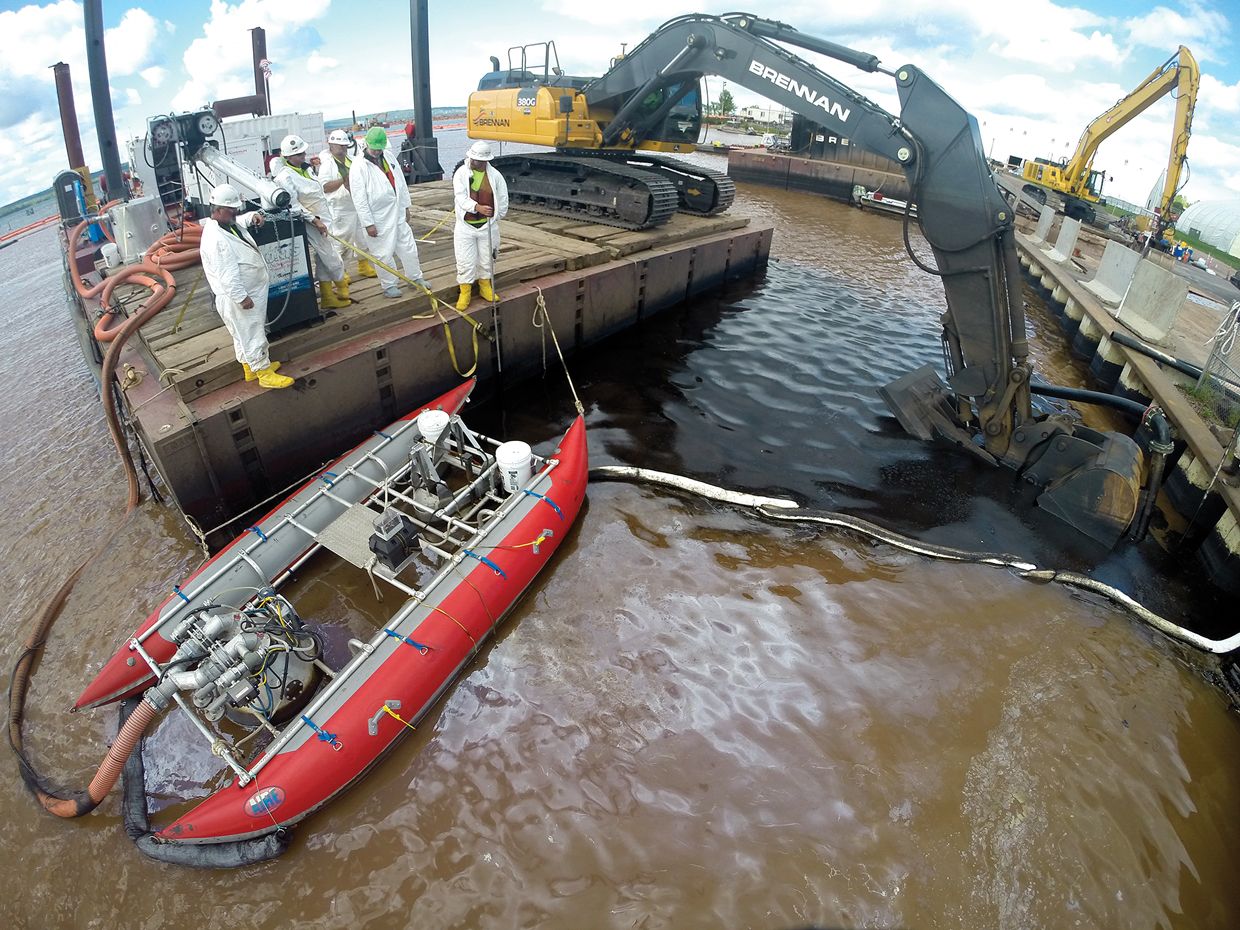 Photo: Larry Herbst Thick of Things: One of Kevin Kennedy's oil skimmers was deployed at a Superfund site on the shores of Lake Superior, where it was able to separate a highly viscous creosote oil from lake waters.
Photo: Larry Herbst Thick of Things: One of Kevin Kennedy's oil skimmers was deployed at a Superfund site on the shores of Lake Superior, where it was able to separate a highly viscous creosote oil from lake waters. There are countless oil tankers, barges, rigs, and pipelines that operate in, around, and through U.S. coastal waters. Every year, some of them leak some of their contents. In a typical year the leakage amounts to no more than a million gallons or so. But every now and then a monster mishap spills considerably more: In 1989, the Exxon Valdez tanker ran aground on a reef and gushed some 11 million U.S. gallons (42,000 cubic meters) of oil into the pristine waters of Prince William Sound, Alaska. In 2005, Hurricane Katrina unleashed more than 8 million gallons (30,000 cubic meters) from Louisiana storage facilities. And even those incidents pale in comparison with the Deepwater Horizon disaster in 2010, in which a drilling rig leased by BP exploded in the Gulf of Mexico, killing 11 people and ultimately releasing some 210 million gallons (almost 800,000 cubic meters) of oil.
Such disasters not only ravage huge, complex, and delicate marine ecosystems, but they are also economically devastating: The damage to tourism and commercial fisheries is often measured in the hundreds of millions of dollars.
To deal with such fiascoes, engineers, chemists, and inventors have devised, sometimes on the fly, a grab bag of equipment, systems, chemicals, and procedures for collecting the oil and removing it, or for breaking it up or burning it in place to lessen its environmental impacts.
Today, the oil-spill-management market is a roughly US $100-billion-a-year industry with hundreds of companies. But multiple studies of the biggest episodes, including the Deepwater Horizon disaster, have questioned the industry's motives, methods, track record, and even its utility.
After decades in the industry, Kennedy, a small player in a big business, has unique perspectives on what ails it. His involvement with oil spills stretches back to 1989, when he bought his first fishing boat and paid for a license to trawl for shrimp near Prince William Sound. He couldn't have chosen a worse time to begin a fishing career. On the first day of the shrimping season, the Exxon Valdez ran aground on Bligh Reef, and Kennedy found himself drafted as a first responder. He spent more than four months corralling oil with his nets and using his fish pumps to transfer the unending gobs of sticky mess into his boat's hold.
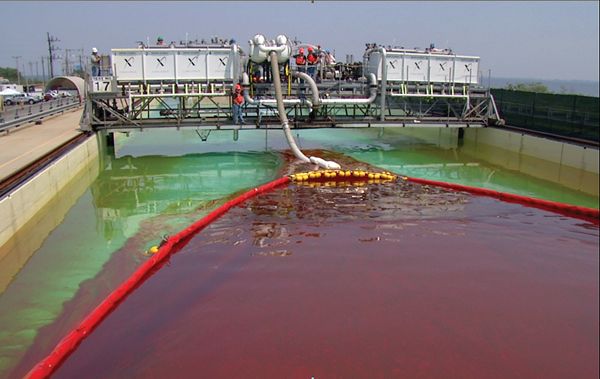
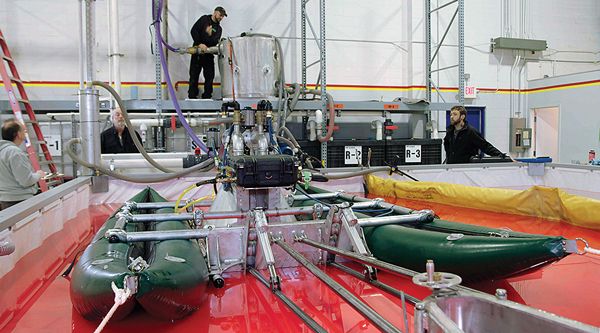 Photos: Larry Herbst Trial Without Fire: Kevin Kennedy's apparatus has been subjected to various controlled tests. In 2011, such tests were conducted as part of the Wendy Schmidt Oil Cleanup XChallenge [top]. In 2017, a smaller version of Kennedy's apparatus underwent testing to obtain an ASTM rating [bottom]. In both cases, the tests were performed with a thick layer of oil [red] on the water's surface, a condition that Kennedy points out rarely occurs in a real spill.
Photos: Larry Herbst Trial Without Fire: Kevin Kennedy's apparatus has been subjected to various controlled tests. In 2011, such tests were conducted as part of the Wendy Schmidt Oil Cleanup XChallenge [top]. In 2017, a smaller version of Kennedy's apparatus underwent testing to obtain an ASTM rating [bottom]. In both cases, the tests were performed with a thick layer of oil [red] on the water's surface, a condition that Kennedy points out rarely occurs in a real spill. Meanwhile, millions of dollars of oil-skimming equipment was airlifted to the nearby port of Valdez, most of it ultimately proving useless. Kennedy has witnessed something similar every time there's a spill nearby: There may be lots of cleanup activity, but often, he insists, it's just to put on a good show for the cameras. In the end, most of the oil winds up on the beach-Nature's mop," he calls it.
In 2004, Kennedy participated in the cleanup that followed the grounding of the cargo ship Selendang Ayu-a tragic accident that cost six sailors their lives and released 336,000 gallons (1,272 cubic meters) of fuel oil into Alaskan waters. After that incident, he became convinced he could design gear himself that could effectively recover the oil spilled on the water before it hit the beach. His design employed fishing nets and fish pumps, normally used to transfer fish from the nets into the holds of fishing vessels. (Fish pumps use vacuum instead of whirling impellers, meaning no chopped-up fish.)
Fast forward to 2010 and the Deepwater Horizon disaster. The amount of oil released into the water by that well blowout seemed limitless-as did the money available to try to clean things up. Desperate for solutions, BP was exploring every avenue, including leasing oil-water separators built by actor Kevin Costner's oil-cleanup company, Ocean Therapy Solutions, now defunct. BP ultimately spent some $69 billion on its response to the disaster, including legal fees.
In the midst of those frenzied cleanup efforts, Kennedy packed up a hastily assembled oil-recovery system and drove from Anchorage to Louisiana. He presented himself to BP, which worked out a contract with Kennedy. But before he could sign it, the oil well was capped.
Although enormous oil slicks still covered the sea, Kennedy was no longer allowed to participate in the cleanup. Only an emergency, the relevant regulators felt, gave them the flexibility to try out new technology to address a spill. With the emergency now officially over, cleanup would be done strictly by the book, following specific U.S. Coast Guard guidelines.
When Oil and WaterDo Mix Kevin Kennedy's open-water oil-spill cleanup system is being marketed under the name Sea Otter by his company, PPR Alaska. Here's how it works.
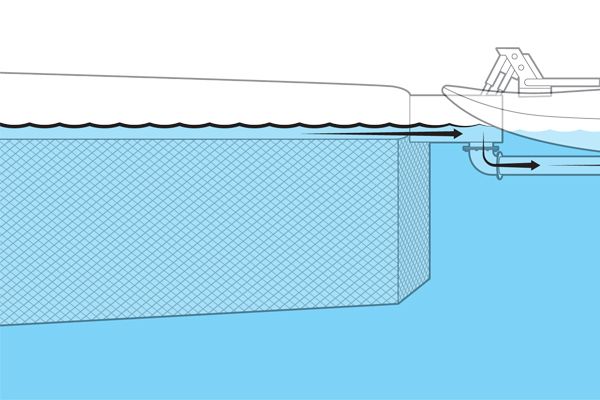 Illustrations: Chris Philpot 1. Two floating arms, arranged in the shape of a V, channel oil floating on the surface as the system is towed forward into a spill.
Illustrations: Chris Philpot 1. Two floating arms, arranged in the shape of a V, channel oil floating on the surface as the system is towed forward into a spill.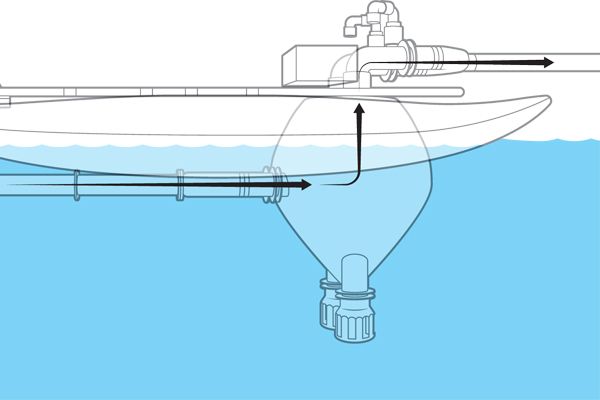 2. Oil and water flow through a pipe to the separator chambers. A one-way valve in the pipe prevents backflow
2. Oil and water flow through a pipe to the separator chambers. A one-way valve in the pipe prevents backflow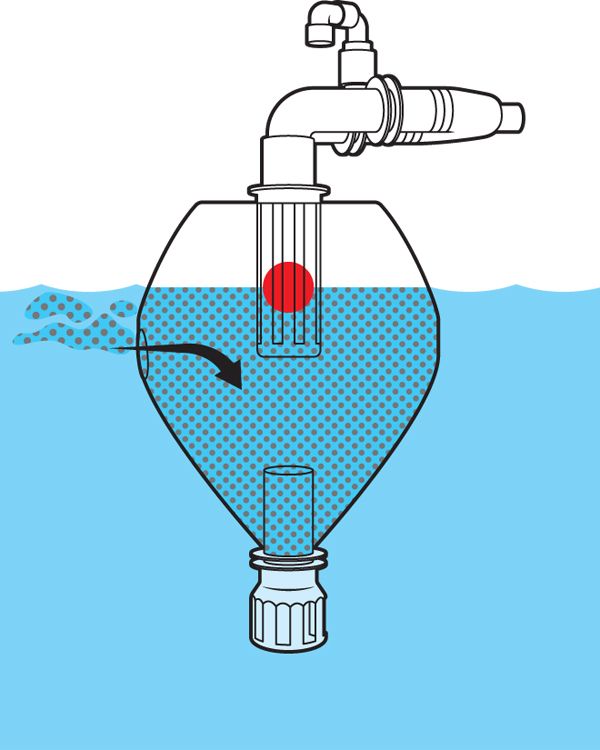 3. Oily water flowing horizontally from the intake pipe fills one of the two chambers, which are situated side by side.
3. Oily water flowing horizontally from the intake pipe fills one of the two chambers, which are situated side by side.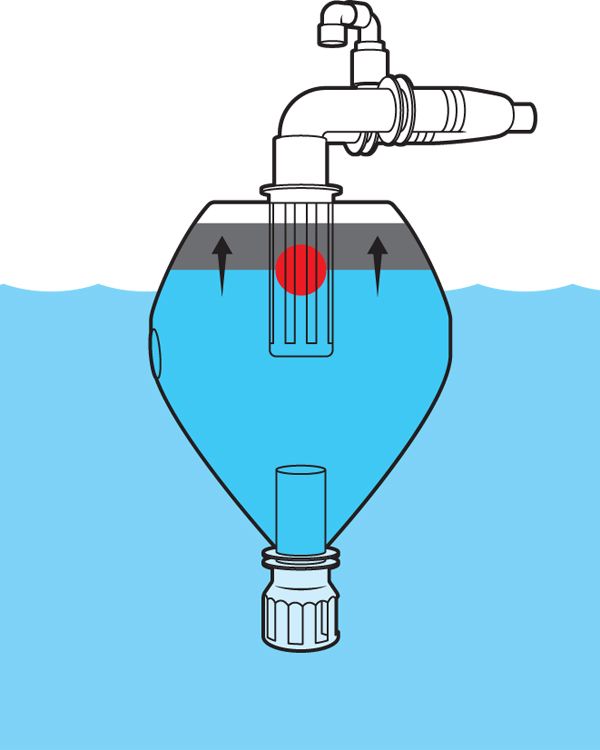 4. Oil and water separate, while both are being raised above sea level by virtue of a vacuum applied by a pump through the pipe above.
4. Oil and water separate, while both are being raised above sea level by virtue of a vacuum applied by a pump through the pipe above.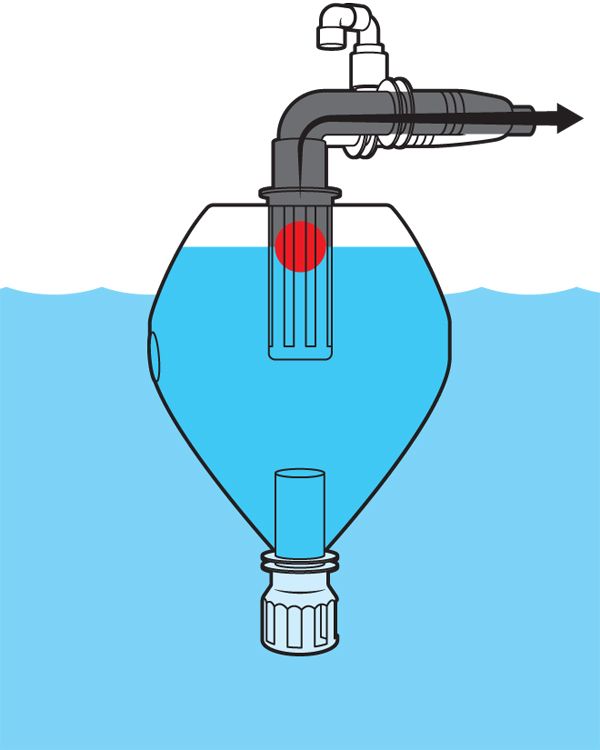 5. An open float valve (whose ball floats above water but below oil) allows oil to be extracted, closing before water can be sucked out.
5. An open float valve (whose ball floats above water but below oil) allows oil to be extracted, closing before water can be sucked out.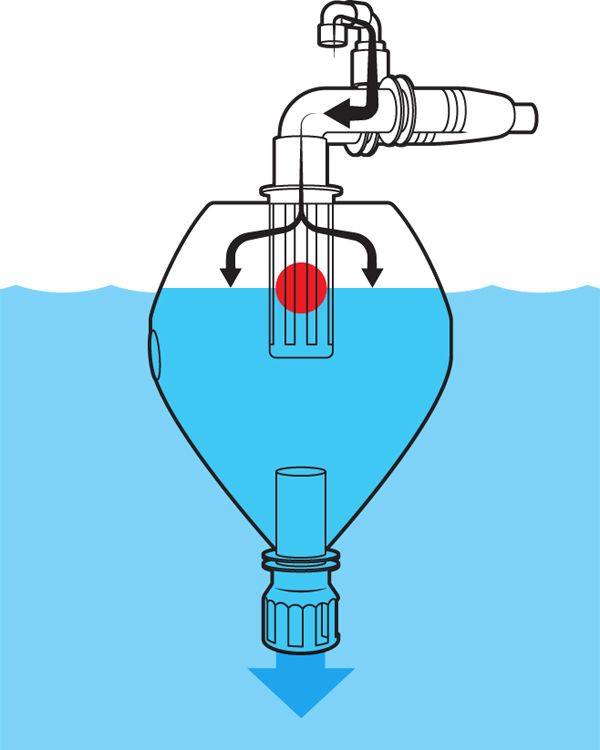 6. Releasing the vacuum allows water to flow out the bottom one-way valve until the water level in the chamber reaches sea level.
6. Releasing the vacuum allows water to flow out the bottom one-way valve until the water level in the chamber reaches sea level.
First and foremost, only equipment from a very short list of certified systems would be used. So Kennedy watched from the shore as others went to work. Less than 3 percent of the oil from the BP spill was ever recovered, despite billions spent on efforts that mostly involved burning the oil in place or applying chemical dispersants-measures for addressing the problem that pose environmental hazards of their own.
In 2011, in the wake of the Deepwater Horizon spill, the XPrize Foundation mounted the Wendy Schmidt Oil Cleanup XChallenge, named for the philanthropist and wife of Eric Schmidt, the former executive chairman of Google. The purpose of the contest was to foster technical advances in the oil-spill cleanup industry. Kennedy submitted his system on something of a lark and was startled to learn he was chosen as one of 10 finalists from among hundreds of entrants, including some of the biggest names in the oil-spill field.
All the global players were there: Lamor, Elastec, Nofi. Some of these are hundred-million-dollar companies," says Kennedy. When I finished packing up the shipping container to go down to the competition, I think I had $123 left in my checking account." His life savings depleted, Kennedy was forced to ask friends for donations to afford the plane ticket to New Jersey, where the competition was being held.
Located in Leonardo, N.J., the Department of the Interior's Ohmsett facility houses a giant pool more than 200 meters long and almost 20 meters wide. Researchers there use computerized wave generators to simulate a variety of open-water environments. Whereas the industry standard for an oil skimmer was 1,100 gallons of oil per minute, the organizers of this XPrize competition sought a machine that could recover upwards of 2,500 gallons per minute with no more than 30 percent water in the recovered fluid.
Kennedy had cobbled together his skimmer from used fishing gear, including a powerful 5,000-gallon-per-minute fish pump. In addition, Kennedy's system used lined fishing nets to capture the oil at the surface. This equipment would be familiar to just about anyone who has worked on fishing boats, which are often the first on the scene of an oil spill. So there would be a minimal learning curve for such first responders.
When the XPrize competition began, Kennedy's team was the second of the 10 finalists to be tested. Perhaps due to inexperience, perhaps to carelessness, Ohmsett staff left the valves to the collection tank closed. Kennedy's equipment roared to full power and promptly exploded. The massive fish pump had been trying to force 5,000 gallons a minute through a sealed valve. The pressure ruptured pipes, bent heavy steel drive shafts, and warped various pressure seals.
Replacement parts arrived with just an hour to spare, narrowly allowing Kennedy to finish his test runs. Although his damaged pump could no longer run at full capacity, his skimmer delivered impressive efficiency numbers. On some of the runs, we got 99 percent oil-to-water ratio," he says.
Kennedy didn't win the contest-or the $1 million dollar prize his fledgling company sorely needed. The team that took first place in this XPrize competition, Elastec, fielded a device that could pump much more fluid per minute, but what it collected was only 90 percent oil. The second-prize winner's equipment, while also pumping prodigious volumes of fluid, collected only 83 percent oil.
Although Kennedy's system demonstrated the best efficiency at the XPrize competition, buyers were not forthcoming. It wasn't surprising. The real problem is you don't get paid by the gallon for recovered oil," says Kennedy, who soon discovered that the motivations of the people carrying out oil-spill remediation often aren't focused on the environment. It's a compliance industry: You're required to show you have enough equipment to handle a spill on paper, regardless of whether the stuff actually works or not."
The problem, in a nutshell, is this: When there's an oil spill, responders are typically hired by the day instead of being paid for the amount of oil they collect. So there's little incentive for them to do a better job or upgrade their equipment to a design that can more efficiently separate oil from water. If anything, there's a reverse incentive, argues Kennedy: Clean up a spill twice as quickly, and you'll make only half as much money.
The key term used by regulators in this industry is EDRC, which stands for Effective Daily Recovery Capacity. This is the official estimate of what a skimmer can collect when deployed on an oil spill. According to the regulations of the Bureau of Safety and Environmental Enforcement, EDRC is computed by multiplying the manufacturer's rated throughput capacity over a 24-hour period by 20 percent...to determine if you have sufficient recovery capacity to respond to your worst-case discharge scenario."
Reliance on the equipment's rated throughput, as determined by tank testing, and assumed effectiveness is at the heart of the agreement hammered out between government and oil companies in the wake of the Exxon Valdez disaster. It's a calculation of what theoretically would work to clean up a spill. Unfortunately, as Kennedy has seen time and again on actual spills, performance in the field rarely matches those paper estimates, which are based on tests that don't reflect real-world conditions.

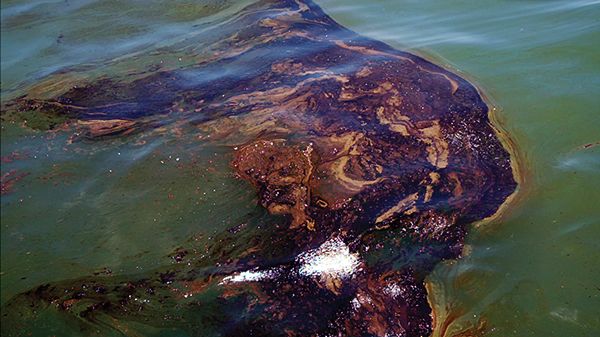
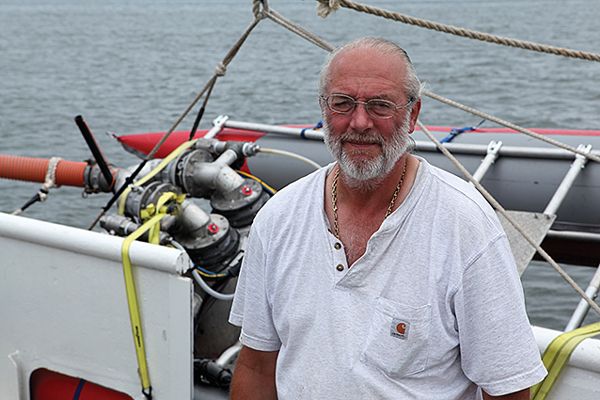 Photos: Larry Herbst Overlooked Gulf Tragedy: A Taylor Energy platform located 16 kilometers from the Louisiana coast was toppled during Hurricane Ivan in 2004 and leaked oil for the next 14 years. The total volume of oil spewed into the Gulf of Mexico rivaled that of the Deepwater Horizon spill of 2010. Kevin Kennedy [bottom] visited the Taylor spill in 2016 to test his Sea Otter oil skimmer [top] under real-world conditions, where the floating oil varied from a thin sheen to thick patches [middle].
Photos: Larry Herbst Overlooked Gulf Tragedy: A Taylor Energy platform located 16 kilometers from the Louisiana coast was toppled during Hurricane Ivan in 2004 and leaked oil for the next 14 years. The total volume of oil spewed into the Gulf of Mexico rivaled that of the Deepwater Horizon spill of 2010. Kevin Kennedy [bottom] visited the Taylor spill in 2016 to test his Sea Otter oil skimmer [top] under real-world conditions, where the floating oil varied from a thin sheen to thick patches [middle]. Even though he thought the rules made no sense, Kennedy needed to get his equipment certified according to procedures established by ASTM International (an organization formerly known as American Society for Testing and Materials). So in 2017 he paid to have his equipment tested to establish its official ratings.
Those recovery ratings are determined by placing skimmers in a test tank with a 3-inch-thick (almost 8-centimeter) layer of floating oil. They are powered up for a minimum of 30 seconds, and the amount of oil they transfer is measured. It's an unrealistic test: Oil spills almost never result in a 3-inch layer of oil. Oil slicks floating on the ocean are usually measured in millimeters. And the thickness of an oil sheen, like that seen at the Taylor spill, is measured in micrometers.
So many tests are really just a pumping exercise," says Robert Watkins, a consultant with Anchorage-based ASRC Energy Services who specializes in spill response. But that isn't a true demonstration of response." The value of ASTM ratings, he explains, is allowing a reproducible apples-to-apples" comparison of oil-spill equipment. He doesn't argue, however, that apples are the right choice in the first place.
Kennedy knows that it's not difficult to game the system to get high numbers. According to ASTM's testing rules, even a monstrous pump that doesn't separate oil from water at all can still get credit for doing the job. If a company stockpiles enough of those pumps in a warehouse somewhere-or maintains enough barges loaded with oil-absorbent pads-it will be certified as having a compliant spill-response plan, he contends. In the event of an actual spill, Kennedy says, most of that gear is useless: Good luck cleaning anything up with pumps and diapers!"
In recent years, the Bureau of Safety and Environmental Enforcement (BSEE) and a consultancy called Genwest have worked to develop a better guide, hoping to replace Effective Daily Recovery Capacity with a different metric: Estimated Recovery System Potential (ERSP). This new measure looks at the entire system functionality and delivers far more realistic numbers.
A highly efficient system like Kennedy's would stack up favorably according to ERSP calculations. But according to Elise DeCola, an oil-spill contingency planning expert with Alaska-based Nuka Research and Planning Group, there has been limited adoption of the ERSP calculator by the industry.
While BSEE recommends ERSP as an industry best practice, they do not require its use," says DeCola. Operators that have deep inventories of low-efficiency skimmers-equipment that is still compliant with current guidelines-could suddenly be forced to invest in new skimmers." For many, moving the goal posts would simply cost too much.
The current rules, with their lack of emphasis on efficiency, accept pumping a large amount of oily water into your tanks-a mixture that must then be disposed of as hazardous waste. The better goal is to remove only the oil, and Kennedy's equipment is about as good as you can get in this regard, with its most recent ASTM-certified oil-to-water rating being 99 percent.
What's more, that test tank" rating matches Kennedy's experiences with his equipment under real-world conditions. Whether on the Taylor slick with its micrometer-thick sheen, a Lake Superior Superfund site with spilled creosote as viscous as peanut butter, or a toxic spill in California's Long Beach Harbor, his efficiency numbers have always been very high, he claims.
Kennedy attributes this performance to his unique separation system. It uses a pair of collection vessels, in which the oil floats to the top of the mixture taken in. A specially designed float valve closes once the oil is drawn off the top. That extraction is done by a vacuum pump, which has the virtue of creating a partial vacuum, causing any water that gets caught up in the oil to boil off. The resultant water vapor is exhausted to the air before it can condense and dilute the recovered oil. The fuel oil his system collects often has even lower moisture content than it did when it came fresh out of the refinery.
Yet even with a skimmer that has remarkable performance, Kennedy has faced an uphill climb to find buyers. In 2016, he offered his equipment to Taylor Energy, only to be turned down. For the next two years, he repeatedly approached the Coast Guard, offering evidence that the Taylor Spill was larger than reported and insisting he had a potential solution. Even on a no-cure-no-pay basis, the Coast Guard wasn't interested.
The Coast Guard shines when it tackles major crises, like Hurricane Katrina or the devastation in Puerto Rico," says retired Coast Guard Capt. Craig Barkley Lloyd, now president and general manager of Alaska Clean Seas. But this was a slowly boiling frog."
It wasn't until 2018 that the Coast Guard was finally goaded to act. The Justice Department had hired Oscar Garcia-Pineda, a consultant who had studied the Taylor Spill, to do an independent assessment, which found the spill to be far more expansive than previously reported. According to the new calculations, the total volume of oil released over time rivaled that of the epic Deepwater Horizon spill. Picking up on that analysis, in October 2018 a Washington Post story labeled it one of the worst offshore disasters in U.S. history."
In response to that newspaper article, the Coast Guard began to look for solutions in earnest. It quickly hired the Louisiana-based Couvillion Group to build a giant collection apparatus that could be lowered onto the seafloor to capture the leaking oil before it reached the surface. In the spring of 2019, Couvillion installed this system, which has since been collecting more than 1,000 gallons of oil a day.
For 14 years after the Taylor spill commenced, oil covered large swaths of the sea, and not a single gallon of that oil was recovered until Kennedy demonstrated that it could be done. The incentives just weren't there. Indeed, there were plenty of disincentives. That's the situation that some regulators, environmentalists, and spill-cleanup entrepreneurs, including this former fisherman, are trying to change. With the proper equipment, oil recovered from a spill at sea might even be sold at a profit.
During Kennedy's trial runs at the site of the Taylor spill in 2016, the crew of the shrimp boat he hired began to realize spilled oil could be worth more than shrimp. With the right technology and a market to support them-those same men might someday be fishing for oil.
This article appears in the June 2020 print issue as Fishing for Oil."
About the AuthorLarry Herbst is a filmmaker and videographer with Cityline Inc., in Pasadena, Calif.